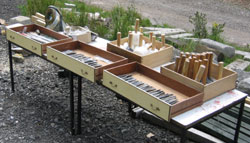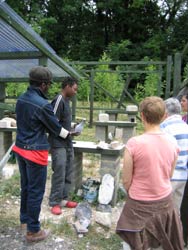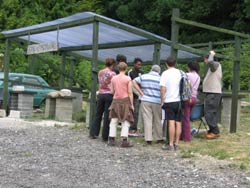Page Contents click on link to go to that section:
1) Sculptors Introduction
2) The Classes
3) What we learnt
4) The Benefits
5) Why Stone is a special medium (in the context of therapeutic classes)
6) Conclusion
To see pictures of the work produced during this course please click here to see pictures
Update: I am currently looking for funding to run another set of Therapeutic Stone Sculpting Classes this year. These classes would benefit 12 people directly and many more indirectly with the subsequent exhibition. There is a queue of people that want to take part because we know it works... I have done the budgets. I need to find £8,500. In return I would deliver a project of at least £22,000 gross value (ie. including value of Mind's support, materials donated and facilities/tools). If anyone reading this has an interest or could help with funding for this project - please do not hesitate to contact me here
Introduction: These classes were inspired over ten years ago when I was making the sculpture 'Love' at Brighton Marina. Although I did not know it at the time, (as I had suffered no mental health problems back then) there was a hospital specialising in mental health at the top of one of the hills overlooking the marina. As my work progressed I had a succession of patients visit with me. For some reason they expressed that they felt at ease around me when I was working on my stone. Apparently this was one of few places outside the hospital they felt safe and comfortable enough to stop a while. I was quite struck by this. Not only that but on market days religious people chose my emerging sculpture as a place to pray. I felt honoured by these actions at the time. The mental health patients eventually worked out where I lived (by following me home I guess) and I started to get home visits. At this time I knew little about mental health so I was ill prepared to handle these visits. I felt for these people and found it hard to turn them away. Little did I know it but I was heading for a crisis of my own.
The experience had planted a seed though. A seed that was to germinate with a lot of help from MIND. Initially MIND helped me get back on my sculpting feet with a grant from the MIND Millennium Fund in 2000. We had intended classes back then but for a variety of reasons this was not to be. Then in 2003 I teamed up with Elvis Mamvura and together we approached MIND for their help in applying to The Arts Council of England for funding to hold some Stone Sculpting Classes. We intended importing some stone from Elvis's home country of Zimbabwe and we hoped the classes would appeal to mental health service users and disadvantaged people from black and ethnic minorities. The hope was that the activity would be of therapeutic value to those involved. This was a pilot project as this had not been tried before.

The Classes: In June and July 2004 about 10 mental health service users gathered together in Stanmer Park to try something different. Along with the two sculptors there was a psychologist/arts psychotherapist present to handle any health matters that arose. Giles Wright and Elvis Mamvura lead the classes and Lynne Ridden gave professional support. The classes were enabled by a grant from The Arts Council of England and the kind donation of MIND's time. The setting up of the classroom was an arduous task taking over 2 months but the results pleasing as you can see above.
| Before the classes started I was quite nervous about how the students would react to the tasks I was going to set them. Making a flat surface, I surmised, may be difficult and not seem very artistic. I was also nervous about whether I could perform and cope with the early mornings - I take medication that makes me drowsy and hard to awaken. With help (by way of phonecalls) I was able to establish an earlier morning routine over a period of weeks. |
|
||
 |
On the first day things seemed to go well. As the students got stuck in I soon lost my nervousness. Where I had worried about the initial task - the students all attained some result and appeared to enjoy the challenge. The first couple of days were intensive but fun. The experience really took me back to my first attempts at working stone and to all the training I received from John Skelton and Weymouth College. It was refreshing and rejuvenating to share my skills with the students. It really put into focus how far I have come with my own skills and in some ways gave me a new respect for those skills and myself. | ||
|
Sadly on the second day of the classes, during the day, I was told that the local Council wanted rid of my whole site from its current position. This news impacted me hard and was to affect my experience considerably throughout the classes. At first I tried to keep it to myself and for a short while I did. My own depression did not help matters. Eventually after a couple of weeks the truth of my long face became known to the group who were shocked also, but supportive of me and understanding. After making the flat surface and a relief carving the students moved on to attempt 3D. By this stage the students had gained much confidence from the exercise in Portland Limestone. We then introduced the African stones - softer and more colourful - with the ability to be polished. The students jumped at these. We let them go at their own pace and choose their own stones. I was surprised at the ingenuity of some of the designs. |
 |
||
The weather was not always kind - we had to put up the rain covers many times. But this did not dampen anyone's enthusiasm to be there working with the stone. Despite quite heavy rain on some days everyone stayed the course. I was surprised and heartened by this. The sense of doing something worthwhile, something people appreciated and benefited from was really born out on these days.
By the third or fourth week there was a real sense of camaraderie becoming self evident in the group. This was partly due, in no small part to the presence of Lynne Ridden, a psychologist and trained art therapist. Her role essentially was to take care of any mental health issues that came up during the classes. But she did much more than that; gathering the group together and getting us to talk as a group. She was also an essential support for me during the classes as I tried to keep my mind off the impending doom of loosing my work site.
| In the second half of the classes I was able - indeed encouraged to pick up my tools and work on my own large stone. The students expressed an enjoyment in seeing me "at work". It was very therapeutic for me to work - but not only that. With the site under threat I was finding it hard, if not impossible to work on my sculpture at other times when I was alone. The classes spurred me on and in some way kept me going whilst the threat to my site sunk in. |
The time seemed to slip by very quickly for everyone involved. By the end of the classes everyone was sad it was over. A number of students had unfinished work so I gave them my approximate working hours and my mobile phone number - they were welcome to come and make use of the facilities. That summer I saw various individuals at different times as they came to finish work.

To see pictures of the work produced during this course please click here to see pictures
What we learnt: We learnt many things running these classes. Crucially as sculptors we learnt that this is not some thing we can do alone. We need to work with an organisation like Mind who obviously have a wealth of experience in the field of mental health, essential to a project like this. Their prior assessment of individuals wishing to take part, and subsequent monitoring is integral to the project's success.
As well as the sculptors - there was an Psychologist/Arts Psychotherapist present throughout all sessions. Mental health being as it is, we soon discovered that the presence of someone trained to deal with mental health patients was essential. They helped to bond the group and produce a harmonious environment. They also provided invaluable support and insite to the sculptors which was a helpful guide in assessing our relative success on a daily basis. Note: I was only able to pay the Psychologist/Arts Psychotherapist less than half her expected wage per hour this time..!
I learnt that the students liked my structured introduction to stone and the tools to work it. Even though the first task was hard and possibly not, in of itself, a piece of art - the students all appeared to enjoy it and gain something useful from it.
We learnt the value of our natural surroundings at Stanmer Park, Brighton. Both as inspiration and as relaxation. Rain or shine - nature does it best..!
We learnt that the material, stone, holds a special significance and interest for those taking part. A quality that I believe makes it a particularily useful material for therapeutic purposes such as these classes. We also learnt that, although not cheap, African Opal (various types) and African Serpentine stones are a joy to work with on the small to medium scale. The participants were all very keen on the African stones. (read more below in Why Stone is a Special Medium)
On a personal level I learnt that I need a stable environment, free from worries about tenure of facilities to be able to successfully deliver a project of this nature.
The Benefits:
For Individuals That Take Part - better health due to (i) improved self esteam through accomplishment and group participation, (ii) improved outlook due to positive activity, (iii) improved social skills through group involvement and final (public) exhibition of their work, (iv) genuine positive thought patterns on which to build good foundations for future ventures (v) the opportunity to discover, experience and or express thoughts and feelings, in a safe environment, that may otherwise be repressed (vi) good outdoor exercise. Of coarse as well as the health benefits the individuals get to create some very unique and personal sculpture which they are free to take away with them.
For Society at Large - Combined with the exhibition of work produced this project delivers a real opportunity to engage the public in a positive debate about mental health. It is a chance for ordinary members of the public to interact with people that have experinced mental health problems, a chance to dispell old, out-dated stigmas. It is an opportunity to educate and an opportunity to make known/celebrate the help that is available to those in mental crisis in our country.
Why Stone is a special medium: Stone is a special medium for several reasons. Unlike wood, stone generally has no grain to fight against - this makes it easier to sculpt in some ways, and certainly less troublesome to the beginner.
In context of these therapeutic classes though, I think stone holds a special significance. That is because more than just about any other material, stone embodies a spiritual presence. It is something I have always felt quite strongly. I first conciously made this connection when making my sculpture 'Love' at Brighton Marina. I had a succession of visitors from a local mental health ward who all said they were particularily comfortable near my stone. Then there were all the instances of people praying by my sculpture - this really set me thinking. Again during these therapeutic classes many remarks were made along these lines.
The African stone is special to these classes too. It brings a variety of colours and a range of finishes that are simply not available in the more commonly available British stones (Lime and Sand stones). The African stones accept polishing readily and the result is a surface that is silken to the touch (hence why they are often named Soap Stones).These are all very appealing characteristics when working on the small scale. Not only that - but the African stone is generally softer and, some may say, easier to work. Pleasing results can be acheived quite quickly in African stone. All these qualities make African stone the ideal medium for these classes.
Whether the spirit is in the stone or the person, or both - what is undeniable is that sculpting in stone is an active, enjoyable process that expends energy and gives the participant mental space and clarity in which to think. To someone with mental ill health, that is gold...
Conclusion: Since the project ended I have heard many nice things said by the students about their experience of the classes. I have also encountered much enthusiasm for further classes along similar lines. For myself I have done much thinking too. I doubt the classes have the ability to be much of an income long term unless I can find more longterm funding - but that is not my main reason for doing them. I have spent a long time working (and living) alone. The classes give me social interaction and a chance to share my enjoyment of stone. They give me the immediacy of human reaction to my work and the satisfaction that in some very tangible way, my work is helping people. These things are important to me and along with changing attitudes are the reason I want to see more classes and exhibitions occur.
Lastly I should like to thank the team at MIND, The Arts Council and Lynne Ridden without whom this project would not have been possible - thankyou.
Update: I am currently looking for funding to run another set of Therapeutic Stone Sculpting Classes this year. These classes would benefit 12 people directly and many more indirectly with the subsequent exhibition. There is a queue of people that want to take part because we know it works... I have done the budgets. I need to find £8,500. In return I would deliver a project of at least £22,000 gross value (ie. including value of Mind's support, materials donated and facilities/tools). If anyone reading this has an interest or could help with funding for this project - please do not hesitate to contact me here
To see pictures of the work produced during this course please click here to see pictures



